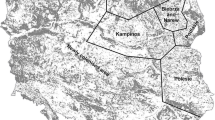Abstract
Increasing deer populations can be controlled through manipulatingharvest limits or season length. While such actions often result in benefitsto hunters, both motorists and the agricultural sector also benefit as alower deer population leads to fewer incidences of harmful human-deerencounters. Traditional recreation demand models are often employed toexamine the welfare implications of changes in daily hunting bag limits.Studies measuring the effects of changes in season length, however, arenoticeably absent from the literature. This study uses a nested randomutility model to examine hunter choice over site and season selection toderive the values of changes in season length.
Similar content being viewed by others
REFERENCES
Ben-Akiva, M. and S. R. Lerman (1985), Discrete Choice Analysis: Theory and Application to Travel Demand. MIT Press.
Bockstael, N. E., M. W. Hanemann and C. L. Kling (1987), ‘Estimating the Value of Water Quality Improvements in a Recreation Demand Framework’, Water Res. Research 23, 951–960.
Bockstael, N. E., K. E. McConnell and I. E. Strand (1989), ‘A Random Utility Model for Sportfishing: Some Preliminary Results for Florida’, Marine Res. Economics 6 245–260.
Borsch-Supan, A. (1990), ‘On the Compatability of Nested LogitModels with Utility Maximization’, J. of Econometrica 43, 373–388.
Campa, H. III, S. R. Winterstein, R. B. Peyton, G. R. Dudderar and L. A. Leefers (1997), ‘An Evaluation of a Multidisciplinary Problem Ecological and Sociological Factors Influencing White-tailed Deer Damage to Agricultural Crops in Michigan’, Trans. 62nd No. American Wildlife and Natural Resources Conference, pp. 431–440.
Cooper, J. C. (1993), ‘A Bioeconomic Model for Estimating the Optimal Level of Deer and Tag Sales’, Environmental and Res. Economics 3(6), 563–579.
Daly, A. and S. Zachary (1979), ‘Improved Multiple Choice Models’, in D. Henscher and Q. Dalvi, eds., Identifying and Measuring the Determinants of Mode Choice. London: Treakfield Press, pp. 335–357.
Forster, L. and F. Hitzhusen (1997), ‘Farmers' Perception of Financial Losses and Benefits from Wildlife’, Journal of the ASFMRA, 30–33.
Hanemann, W. M. (1982), ‘Applied Welfare Analysis with Quantitative Response Modles’, California Experiment Station Working Paper No. 241.
Hausman, J. A., G. K. Leonard and D. McFadden (1995), ‘A Utility-Consistent, Combined Discrete Choice and Count Data Model: Assessing Recreational Use Losses Due to Natural Resource Damage’, Journal of Public Economics 56, 1–30.
Herriges, J. A. and C. L. Kling (1996), ‘Testing the Consistency of Nested Logit Models with Utility Maximization’, Economics Letters 50(1), 33–40.
Herriges, J. A. and C. L. Kling (1997), ‘The Performance of Nested Logit Models When Welfare Estimation is the Goal’, American Journal of Agricultural Economics 79(August), 792–802.
Herriges, J. A., C. L. Kling and D. J. Phaneuf (1999), ‘Corner Solution Models in Recreation Demand: A Comparison of Competing Frameworks’, in J. A. Herriges and C. L. Kling, eds., Valuing Recreation and the Environment: Revealed Preference Methods in Theory and Practice. Aldershot: Edward Elgar.
Kaoru, Y., V. K. Smith and J. L. Liu (1995), ‘Using Random Utility Models to Estimate the Recreational Value of Estuarine Resources’, American Journal of Agricultural Economics, 1, 141–151.
Keith, J. and K. Lyon (1985), ‘Valuing Wildlife Management: A Utah Deer Herd, Western’, Journal of Agricultural Economics 10, 216–222.
Kling, C. L. and J. A. Herriges (1995), ‘An Empirical Investigation of the Consistency of Nested Logic Models with Utility Maximization’, Amer. J. of Ag. Economics 77 (November), 875–884.
Kling, C. L. and C. L. Thomson (1996), ‘The Implications of Model Specification for Welfare Estimation in Nested Logit Models’, American Journal of Agricultural Economics 78(February), 103–114.
Loomis, J., M. Creel and J. Cooper (1989), ‘Economic Benefits of Deer in California: Hunting and Viewing Values’, Institute of Ecology Report #332. University of California, Davis.
Maddala, G. S. (1983), Limited-Dependent and Qualitative Variables in Econometrics. Cambridge: Cambridge University Press.
McFadden, D. (1979), ‘Qualtitative Methods for Analyzing Travel Behavior of Individuals: Some Recent Developments’, in D. Hensher and P. Stopher, eds., Behavioral Travel Modeling. London: Croom Helm, pp. 279–318.
McFadden, D. (1981), ‘Econometric Models of Probabilistic Choice’, in C. Manski and D. McFadden, eds., Structural Analysis of Discrete Data with Econometric Applications. Cambridge: MIT Press, pp. 198–272.
McFadden, D. (1989), ‘A Method of Simulated Moments for Estimation: Discrete Response Models Without Numerical Integration’, Econometrica 57, 995–1026.
Morey, E. (1999), ‘Two RUMs UnCLOAKED: Nested-Logit Models of Site Choice and Nested-Logic Models of Participated and Site Choice’, in J. A. Herrings and C. L. Kling, eds., Valuing the Environment Using Recreation Demand Models. Aldershot: Edward Elgar, pp. 65–120.
Morey, E. R., R. D. Rowe and M. Watson (1993), ‘A Repeated Nested-Logit Model of Atlantic Salmon Fishing’, American Journal of Agricultural Ecnomics 75(3), 578–592.
Ohio Department of Public Safety (1997), Deer-hit death, injury, and economic loss report.
Parsons, G. R. and M. J. Kealy (1995), ‘A Demand Theory for the Number of Trips in a Random Utility Model of Recreation’, Journal of Environmental Economics and Management 29, 357–367.
Tonkovich, M. (1997), Personal Conversation. Ohio Department of Natural Resource — Division of Wildlife. Waterloo Research Station. New Marshfield, Ohio.
Tonkovich, M. (2000), Personal Conversation. Ohio Department of Natural Resource — Division of Wildlife. Waterloo Research Station. New Marshfield, Ohio.
Van Deelen, T. R., H. C. Campa, J. B. Haufler and P. D. Thompson (1997), ‘Mortality Patterns of White-tailed Deer in Michigan's Upper Pennisula’, Journal of Wildlife Mgmt 61(3), 903–910.
Author information
Authors and Affiliations
Rights and permissions
About this article
Cite this article
Schwabe, K.A., Schuhmann, P.W., Boyd, R. et al. The Value of Changes in Deer Season Length: An Application of the Nested Multinomial Logit Model. Environmental and Resource Economics 19, 131–147 (2001). https://doi.org/10.1023/A:1011121503549
Issue Date:
DOI: https://doi.org/10.1023/A:1011121503549




